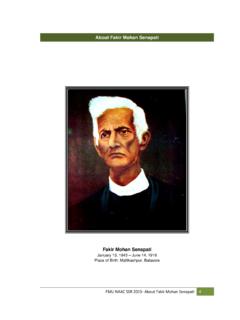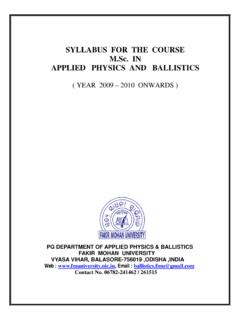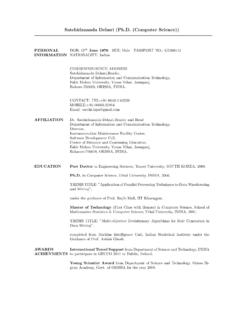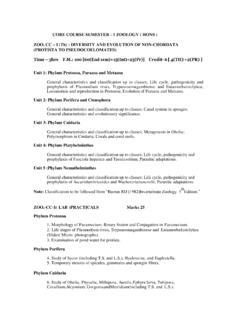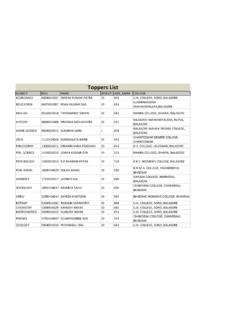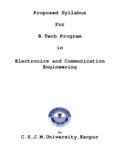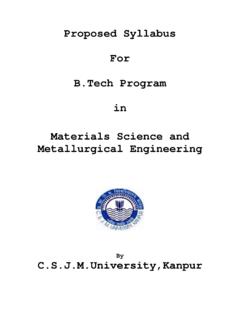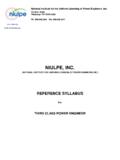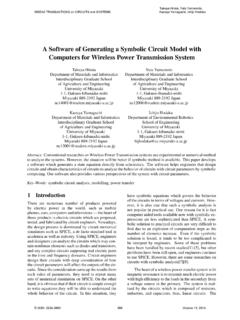Transcription of SYLLABUS FOR THE COURSE M. SC. IN PHYSICS …
1 POST GRADUATION DEPARTMENT OF APPLIED PHYSICS AND. BALLISTICS, F. M. UNIVERSITY, BALASORE. SYLLABUS FOR THE COURSE M. SC. IN. PHYSICS (SFC MODE). 2014 onwards 1. Department of Applied PHYSICS and Ballistics Revised SYLLABUS structure with effective from Dt. Post approved by BOS on Dt. (SFC Mode). in PHYSICS Semester Marks Credit 1st semester 300 24. 2nd semester 300 24. 3rd semester 300* 24. 4th semester 300 24. Total 1200 96. *choice based credit paper is selected by the student of other PG Depts. 2. Department of Applied PHYSICS and Ballistics Revised SYLLABUS structure with effective from Dt.
2 Post approved by BOS on Dt. (SFC MODE). in PHYSICS First Semester Code Name Mark Credit APAB-101 Classical Mechanics 50 04. APAB-102 Mathematical Methods in PHYSICS 50 04. APAB-103 Electronics & Computer 50 04. Programming APAB-104 General Instrumentations 50 04. APAB-105 Practical: Electronics 100 08. Total 300 24. Second Semester Code Name Mark Credit APAB-201 Statistical Mechanics 50 04. APAB-202 Quantum Mechanics 50 04. APAB-203 Fluid Dynamics 50 04. APAB-204 (B) Atomic and Molecular PHYSICS 50 04. APAB-205 Practical: Computational PHYSICS : 100 08. Total 300 24. Third Semester Code Name Mark Credit APAB-301 Solid State PHYSICS 50 04.
3 APAB-302 Electrodynamics 50 04. APAB-303 Nuclear & Particle PHYSICS : 50 04. APAB-304 Modern PHYSICS and Electronics 50 04. APAB-305 Practical: Modern PHYSICS & Material 100 08. Science APAB-306 Fakir Mohan Studies 100(Non Credit) 00 (Non credit paper). Total 400 24. 3. in PHYSICS Fourth Semester (out of 3 special papers 1 special paper is mandatory). Special Paper-II Electronics Special Paper-III Nuclear & Particle PHYSICS Special Paper-IV Condensed matter PHYSICS Special Paper-I (Electronics). Code Name Mark Credit APAB-401(B) Electrical circuit & Control: 50 04. APAB-402(B) Optoelectronics & Optical 50 04.
4 Communication: APAB-403(B) Pulse & Digital circuit: 50 04. APAB-404 (B) Advance electronics practical: 50 04. APAB-405 (B) Project & Grand viva: 100 08. Total 300 24. Special Paper-II (Nuclear and Particle PHYSICS ). Code Name Mark Credit APAB-401(C) Nuclear structure 50 04. APAB-402(C) Nuclear reaction & Nuclear 50 04. Astrophysics APAB-403(C) Particle PHYSICS 50 04. APAB-404 (C) Seminar: 50 04. APAB-405 (C) Project & Grand viva : 100 08. Total 300 24. in PHYSICS Special Paper-III (Condensed Matter PHYSICS ). Code Name Mark Credit APAB-401(D) Condensed Matter PHYSICS -I 50 04. APAB-402(D) Condensed Matter PHYSICS -II 50 04.
5 APAB-403(D) Condensed Matter PHYSICS -III 50 04. APAB-404 (D) Seminar: 50 04. APAB-405 (D) Project & Grand viva : 100 08. Total 300 24. 4. SEMESTER-I. PAPER-APAB-101 Marks: 40. SUB: CLASSICAL MECHANICS Internal Marks: 10. Total Marks: 50. UNIT-I. Survey of the elementary particles: Mechanics of a particle-Mechanics of a system of particles . Constraints-D'Alembert's principle and Lagrange's equations-velocity dependent potentials and the dissipation function, simple applications of the Lagrange formulation. Variational Principle and Lagrange's Equations: Some techniques of the calculus of variations-Derivations of Lagrange's equations-from Hamilton's principle-Extension of Hamilton's principle to nonholonomic systems-Advantages of variational principle formulation-conservation theorems and symmetry properties.
6 UNIT-II. Two body Central force Problems ; Reduction to the equivalent one-body problem-The equations of motion and first integrals-The equivalent one-dimensional problems and classification of orbits-The virial theorem-The differential equation of orbit and integrable power-law potentials-conditions for closed orbits (bertrand's theorem)-The Kepler Problem Inverse square law of force-The motion in time in the Kepler problem-The Laplace-Runge-Lenz vector-Scattering in a central force field, Transformation of the scattering problem to the laboratory co-ordinates. UNIT-III. The Kinematics of Rigid Body Motion: The independent co-ordinates of a rigid body-Orthogonal transformation-Formal properties of the transformation matrix, The Euler Angles, Euler's theorem on the motion of a rigid body-Finite rotations-Infinitesimal rotations-Rate of change of vector-The Coriolis force.
7 UNIT-IV. The Rigid Body Equations of Motion: Angular momentum and kinetic energy of motion about a point-Tensor and dyadics-The inertia tensor and the momentum of inertia-The eigen values of the inertia tensor and the principal axis transformation-Methods of solving rigid body problems and the Euler equations of motion Torque-Free motion of a rigid body-The heavy symmetrical top with one point fixed-Precession of the equinoxes and of satellite orbits-Precession of system of changes in a magnetic field. TEXT BOOKS: 1 Classical Mechanics-Herbert Goldstein, Addison-Wesley/Narosa (Indian Student Edition).
8 2 Classical Mechanics-Rana and Joag, Tata-McGraw-Hill REFERENCE BOOKS: 1 Classical Mechanics of particles and Rigid body-Kiran C. Gupta, New age Publishers 2 Classical Uppadaya 3 Classical mechanics , Meenakshi prakashan, 1970, New Delhi. 4 Introduction to classical mechanics and , Tata McGrawHill, 1980, New Delhi. 5 An Introduction to Continuum Mechanics-M. E. Gurtin, Academic Press 5. PAPER-APAB-102 Marks: 40. SUB: Mathematical Methods in PHYSICS Internal Marks: 10. Total Marks: 50. UNIT-I. Vector Algebra and Vector Calculus: Differential Operators: Gradient, Divergence and curl, Vector Integration, Gauss Theorem, Stoke's Theorem, Green's Theorem, Curvilinear Co-ordinates, Spherical Polar co-ordinates, cylindrical co-ordinates.
9 LinearAlgebra: Various types of matrices, rank of matrix, Types of linear equation, Linear dependence and independence of vectors, eigen values and eigen vectors, Cayley Hamilton Theorem, Digonalisation of matrices, Elementary ideas about Tensors, Types of tensors, Transformation properties, Introductory group theory, Generators of continuous groups. UNIT-II. Complex Analysis: Complex Algebra, Cauchy-Riemann condition, Cauchy's Integral Theorem, Cauchy's Integral Formula, Taylor's Theorem, Laurent's Theorem, Singularities, Residues, Residue Theorem and Evaluation of Integrals.
10 Fourier Series, Fourier and Laplace Transforms. UNIT-III. Series solution-Frobenous 's differential equation and its solution, Bessel's functions, Recurrence formula, Generating function, Legendre equation and its solution, Legendre's Polynomial, Rodrigue's formula, laguerre's differential equation, Laguerre's functions, Hermite polynomials. UNIT-IV. Wave equation, Heat equation, Possion equation. Theory of Probability: Mean, Median, Mode Dispersion Standard Deviation Binomial, Poisson's and Gaussian Distribution Gauss error curve -Chi-square Test. TEXT BOOKS: 1 Mathematical Methods for Physicist: G.
